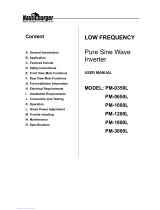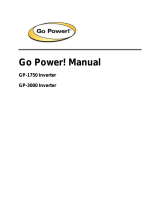
3
SECTION 1 | Important Safety Instructions
1.1 THIS MANUAL CONTAINS IMPORTANT INFORMATION REGARDING SAFETY, OPERATION, MAINTENANCE
AND STORAGE OF THIS PRODUCT. BEFORE USE, READ AND UNDERSTAND ALL CAUTIONS, WARNINGS,
INSTRUCTIONS AND PRODUCT LABELS, PLUS YOUR VEHICLE’S BATTERY MANUFACTURER GUIDELINES.
FAILURE TO DO SO COULD RESULT IN INJURY AND/OR PROPERTY DAMAGE.
1.2 To ensure reliable service, your power inverter must be installed and used properly. Please read
the installation and operating instructions thoroughly prior to installation and use. Pay particular
attention to the WARNING and CAUTION statements in this manual. The CAUTION statements advise
against certain conditions and practices that may result in damage to your inverter. The WARNING
statements identify conditions or practices that may result in personal injury. Read All Instructions
Before Using This power inverter!
1.3 WARNINGS!
TO REDUCE THE RISK OF FIRE, ELECTRIC SHOCK, EXPLOSION OR INJURY
1. The AC output of the unit should never be connected directly to an Electrical Breaker Panel
/ Load Center which is also fed from the utility power / generator. Such a direct connection
may result in parallel operation of the different power sources and AC power from the utility
/ generator will be fed back into the unit which will instantly damage the output section
of the unit and may also pose a re and safety hazard. If an Electrical Breaker Panel / Load
Center is fed from this unit and this panel is also required to be fed from additional alternate
AC sources, the AC power from all the AC sources (like the utility / generator / this inverter)
should rst be fed to an Automatic / Manual Selector Switch and the output of the Selector
Switch should be connected to the Electrical Breaker Panel / Load Center. Samlex America,
Inc. Automatic Transfer Switch Model No. STS-30 is recommended for this application.
2.
W
orking with the unit may produce arcs or sparks. Thus, the unit should not be used in
areas where there are ammable materials or gases requiring ignition protected equipment.
These areas may include spaces containing gasoline-powered machinery, fuel tanks, battery
compartments and engine compartments.
3.
In NTX-3000-12, the Neutral terminal of the NEMA L5-30R outlets is electrically isolated from its
Ground terminal and also from the metal chassis of the inverter. Hence, the Neutral terminal
will be at elevated voltage of around 66 VAC with respect to the Ground terminal and with
respect to the metal chassis of the inverter. DO NOT TOUCH THE NEUTRAL TERMINAL!
4.
In NTX-1000-12, NTX-1500-12 and NTX-2000-12, the Neutral terminals of the Dual NEMA5-
20R GFCI AC outlets are bonded to their Ground terminals and also to the metal chassis of
the inverter. Hence, the Neutral terminals of the outlets will be at 0V with respect to their
Ground terminals and with respect to the metal chassis of the inverter.
5. DC input is non-isolated from AC output.
6.
Before working on an AC load connected to the inverter
, switch OFF the inverter or, remove
the power cord of the AC load from the inverter or from the multiple outlet power strip
connected to the inverter. Switching OFF the AC load or the power strip disconnects only
the "Line / Hot" line. However, the Neutral line remains connected. As indicated above, in
NTX-3000-12, the Neutral will be at 60V with respect to Ground/chassis. Hence, touching any
section of the load connected to the Neutral will produce electrical shock!
7.
Do not make any electrical connections or disconnections in areas designated as IGNITION
PROTECTED. This includes 12 VDC cigarette plug connections, and terminal connections.
8. This is not a toy - keep away from children.
9. Do not insert any object into the ventilation slots or the fan opening(s).






















